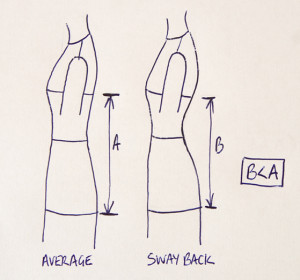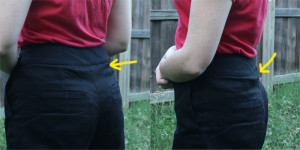To adjust or not to adjust? A pattern, that is…
I’ve been thinking lately about alterations we sew-ers have to make to patterns to get a good fit. If you’ve been sewing long enough you learn which types of adjustments you almost always have to make to every pattern. For example – shortening for the short-waisted, shoulder seam changes for the slope-shouldered, back neck gaping on people who have what a friend has dubbed “computer neck.” There’s also broad-back adjustments, armhole adjustments, hip to waist ratio adjustments. Everyone has special needs when it comes to pants and then there’s probably the most common: full or small bust adjustment.
I’m lucky that I only have a two main changes that I need to make to patterns: sway back and wider sleeves/armholes.
But I’m also a lazy sew-er and don’t like to make adjustments. I can usually get away with not fixing smaller sleeves and I like flutter sleeves because they’re extra roomy. But I also tend to ignore the sway-back issue altogether. Maybe it’s because I never look at myself from behind so I don’t care.
This also brings up the idea of overfitting that sew-ers often do. We’re nit picky about every detail on a garment we make ourselves but when we buy RTW we don’t notice as much.
Take this blouse I drafted last week as an example – I probably should have done a sway back adjustment because you can see how the fabric pools in back. But if this was a shirt I found at the Gap I’d never consider that a problem. Before sewing I didn’t even know what a “sway back” was. I guess ignorance is bliss in this case. Thinking that the shirt fits fine would save me extra time on the drafting table.
With shirts the sway back issue doesn’t matter much but on these new high-waist shorts I just finished I can’t tell if I am bothered enough to go rip off the waist band and make a post-sewing adjustment. When I stand normally (with a sway back) I get some small rippling up by the center waistband which goes away if I tilt my hips in a different position but who wants to walk around all uncomfortable just so her shorts sit correctly?
But if these shorts were in a store, would I even care or notice? Is it that big of a problem that I should go back and fix them? And I should note that I absolutely despise returning to an old project to fix a mistake. It’s like having to go back to your old boyfriend’s house because you forgot to take your CDs with you when you moved out. I just want to move on with my (sewing) life!
On the other hand, some people absolutely have to do adjustments no matter what – like the FBA folks. If they don’t then their garment just won’t be wearable.
So here are my questions:
- Would my little sway back shorts issue annoy you enough to grab the seam ripper for a do-over?
- What adjustments do you often have to make and do you ever skip them to save time or effort?
- I didn’t make a muslin for these shorts. Instead I cut extra big seam allowances for fitting and my sway back problem didn’t exist until I added the waist band. If you are one who has many adjustments do you always make muslins just to be extra sure about the fit?
I’m still on the fence about what I’ll do because these shorts have necessarily complicated to make and making another fix is just going to annoy me more. But then again I’ll be wearing them far longer than I’ll be annoyed by them so maybe it is worth the work…



Dixie, I am with you on going back to fix things on garments. I love to sew but dislike making alterations to garments I’ve sewn or RTW garments. I have some summer shorts and very casual pants that need to be altered because I’ve lost a few pounds and even more because of my sway back. Most typically, I bring my alterations to a husband and wife tailor/alterations team near me (lazy…I know!).
If the rippling on the shorts was uncomfortable, I would fix it. If not, then no, because I am not a shirt tucker.
In answer to the muslin question, I’ll muslin something I want to perfect the fit on, but if it is something I think will be ok, I may make a wearable muslin with an inexpensive fabric that I’m not terribly invested in.
I am not one to skip adjustments, but I sometimes take shortcuts, like blending sizes on a pattern when tracing.
Love your high waisted shorts!
I think about this all the time. I am extremely critical of the fit and finish of clothes that I make, but like you, not so much of RTW. I guess I’m always worried about someone commenting on the ones that I’ve made myself because of the fit or finish. I don’t want people to notice my clothes because they look amatuerish or Becky Home Eky. Don’t fix the shorts. They look fine.
I hate having to go back as well but I do. In this case, it’s such an easy fix that I’d have to do it (you know, after they sat around in my sewing room for a few months). I wouldn’t remove the whole waist band, I’d just undo what I need to to shove that extra up and resew it.
Oh and, I do have the sway back issue and it’s something I always looked at in RTW but didn’t find to be an issue as often as it is in sewing patterns. Actually, who am I kidding, years ago there was such a big difference between my hips and waist that I could rarely get a piece of clothing to fit both so with all of that billowing around the waist the sway back issue couldn’t even be seen.
Ahhhhhh! I have a shorts muslin I’ve been puzzling over with the same issue– extra fabric puffing out underneath the waistband. I couldn’t figure out what that was all about! Thanks for sharing!
I love your sewing life/old boyfriend analogy – couldn’t agree more. But Eich, there is nothing worse than having to revisit a completed project to made additional adjustments. In this case, I would just ignore it and make note for future reference if I was to make the pattern in question again. But I usually make toiles for everything (I’m pretty particular) and I have to be super careful that I don’t overfit – I’ve been there before. But like you mentioned – our standards are lower when it comes to RTW which means it’s unlikely anyone but you will notice. I take it these are the sweet shorts? 🙂
i agree with everything you said and yes, these are the sweet shorts 😉
I would probably want to fix it, only because you tend to be more finicky with your own made clothes, because you feel you are in a position to fix, so you want to do the best you can. But if I saw it on someone else I wouldn’t think anything of it.
I know what you mean, I’ve looked at RTW clothes I’ve bought and wonder how on earth I thought it fitted! Also garments I’ve made myself I’m ultra aware of every slight fitting issue and have a tendency to point them out all the time. Like Little Betty I don’t actaully want people to know I’ve made the clothes myself so I want it to fit well otherwise whats the point? I might as well buy RTW clothes that fit ok but my making my own I can fit it properly, although I’m still learning on that score. My regular fitting problem that old ‘computer neck’ and still learning the best way to do that….
oh, that computer neck… cutting the back neckline lower (for a collarless design) or some good old neckline darts would probably be the easiest thing. I think in the next few years “computer neck” will be a common adjustment for many of us!!
Since sewing I became very critical of RTW less than impressive fit and those small bulges bother so much I don’t buy the item unless fits perfectly making shopping a bit more complex and tiring than before. I lengthen all my items automatically but anything else I will pin fit the pattern and add the changes while sewing. I hate doing Muslims so I guess I always live on the dangerous side of sewing lol. I have small neck, and dowadgers hump so I always have to creakily think how I’m fixing it.
I tend to cut extra wide seam allowances where I need them and then fit the clothes. I think the shorts look great – they are a casual item, let them be. I think falling into the idea that we have to make perfect-fit clothes every time is a recipe for disaster.
I wouldn’t bother about the shorts. Just make a note for next time. I hate having to go back and alter stuff, but sometimes you just have to. I usually have to widen the back and lengthen all of my tops. I’m still learning how to “read” a pattern so I can make most adjustments without having to do more than one muslin. (See you on Tuesday!)
I’m an overfitter. I mess things up before they have a chance in the world! :0
That said, I always waffle on the swayback – you’re right, it’s in the back after all. And on a flat pattern, it shortens but widens the pattern piece and there’s always still pooling, so these days I’m more likely to skip it.
I wouldn’t mess with your shorts if they don’t bother you. I avoid muslins, if I can, preferring to pay special attention to the pattern’s final garment measurements and comparing them to an existing garment that fits perfectly.
I typically have to do an SBA and adjustments for my “full waist” and “protruding belly” which is two sizes or so larger than the rest of me. Sometimes I’ll just grade up and that’s enough, but I find myself avoiding princess seam patterns because it’s a real pain to adjust along so many seamlines (I really want to do the Colette Parfait, but I keep avoiding it because of all the pieces/adjustments!). In fact, I feel like most sewers move onto harder patterns as they get better, I feel like I’m moving onto easier ones — easier to get a better fit, less exhaustion.
That’s an interesting idea – moving on to simpler patterns to save time and pain. I hear you about princess seams and big adjustments. It’s just to many places to fix!
Ah, this is me too! I started sewing garments with more complicated patterns, but I never altered them to fit because I didn’t know how, and now that I do know how I don’t want to! I absolutely judge patterns now by how complicated they are. I gravitate mostly toward 3 or 4-piece knit dress patterns that I can use a simple SBA technique on if necessary.
Once a garment is about 80% completed I’m not going back in there with the seam ripper. Very rarely do I ever go back in and fix something unless its a really easy fix (taking in the waist, or narrowing the leg of pants). Because I usually find, while it bothers me right after I sew it and I might be like “dang it! its not perfect!” after awhile I totally forget about it and turn the same blind eye that I’ve turned to my RTW clothes for years. A little fabric bubble back where I can’t see it? Yeah… I wouldn’t bother!
I do try to make muslins, especially for new patterns or if I’m using especially nice fabric, and also because I’m not always sure what adjustments I’ll have to make. I think I’ve been guilty of overfitting in the past, so I’m trying to lay off a bit.
I always modify the pattern for height and swayback. Once I found out it what needed to be done I did it. And, strangely, it’s not a problem I had with RTW because back when I bought clothes I only bought petite. It’s frickin’ easy to fix so why not? I mean the whole point of sewing (apart from not supporting slave labour) is better fit XD
Sherry’s method is the one I use, really simple and I’ve applied it a few times on different pattern styles! It’s awesome. I’m pretty average height so I don’t think I’ve ever had to adjust for that in the torso.
FIT!! (That’s one of the main reasons I sew — or at least, that’s how I first got obsessed.) Can’t wait until I really have a handle on fitting though, as I have FBA, short-waist, long-legs “computer neck” and pronounced sway back. Also, one shoulder is higher than the other (“purse shoulder”?) WAAA! Fit just seems to be the hardest part of sewing. One thing I’ve noticed: since learning to sew, I am less willing to wear ill-fitting RTW clothes. I seem to alter more than I used to. Still there remains a definite skill gap. So I am over-aware and under-skilled. Painful.
Honestly I haven’t done enough pattern seeing to make adjustments. But last fall in my sewing class my instructor had me take in the back of my dress. I was higher up though, not a sway back problem. Though I always have problems with straps slipping off and gapping shoulders. I’m not really sure how to fix it. Maybe when I have more pattern experience I will work on pattern adjustments. Personally I don’t like fixing things, usually I just let it sit there and never wear it. I think these short look fine 🙂 I probably wouldn’t fix them. But that’s me.
Lately I’ve been going into my closet and fixing quite a few things that I put behind me or tried to ignore. There is so much I didn’t notice until I started sewing more, but swayback is something I’ve always noticed even when I didn’t know what it was called. I used to take even cheap H&M pants to ACe tailor to get adjust the swayback or back gapping.